YAMAHA SUV 1200 2001 Repair Manual
Manufacturer: YAMAHA, Model Year: 2001, Model line: SUV 1200, Model: YAMAHA SUV 1200 2001Pages: 135, PDF Size: 21.67 MB
Page 61 of 135
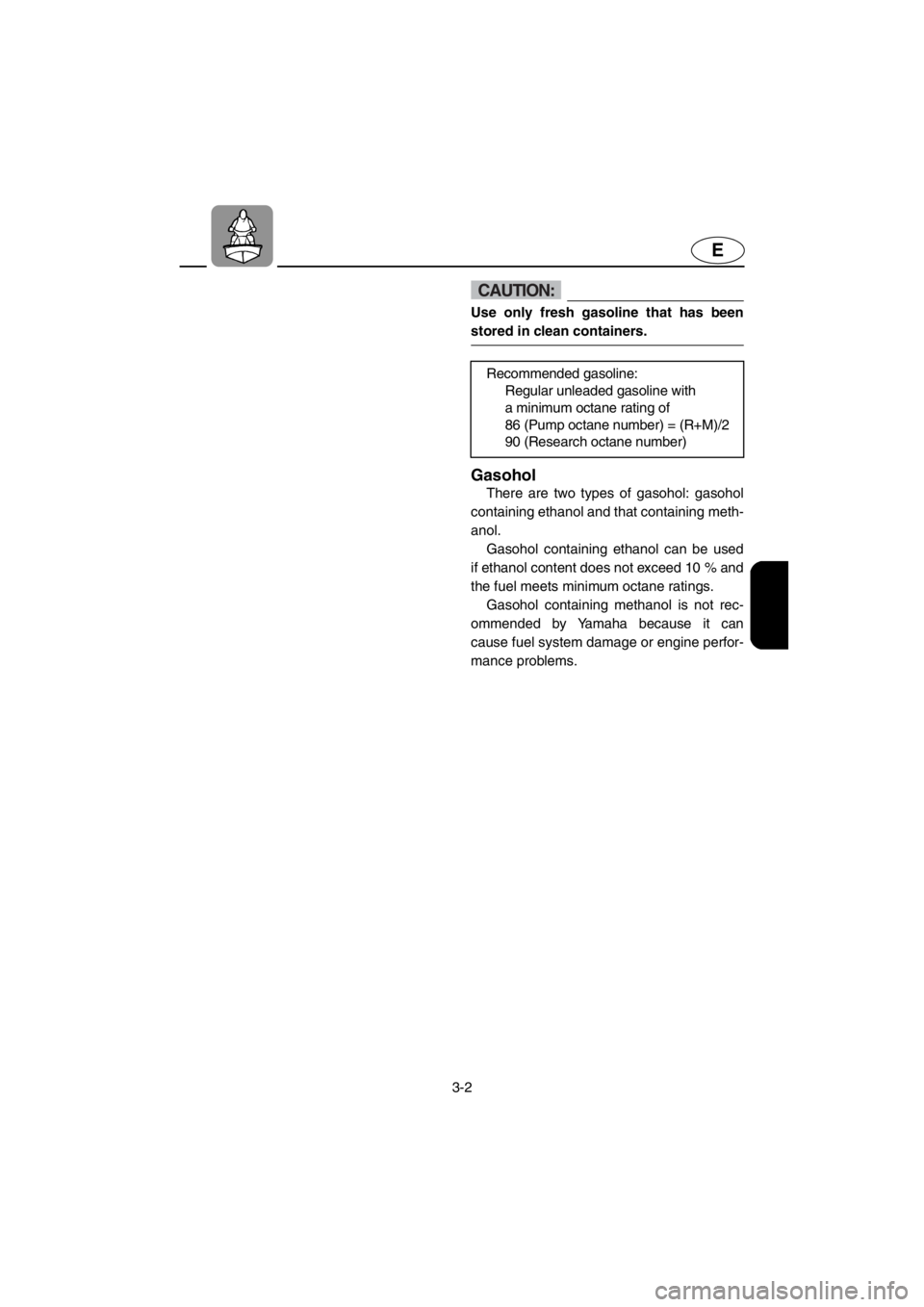
3-2
E
CAUTION:
Use only fresh gasoline that has been
stored in clean containers.
Gasohol
There are two types of gasohol: gasohol
containing ethanol and that containing meth-
anol.
Gasohol containing ethanol can be used
if ethanol content does not exceed 10 % and
the fuel meets minimum octane ratings.
Gasohol containing methanol is not rec-
ommended by Yamaha because it can
cause fuel system damage or engine perfor-
mance problems.Recommended gasoline:
Regular unleaded gasoline with
a minimum octane rating of
86 (Pump octane number) = (R+M)/2
90 (Research octane number)
E_GU5-71-3.fm Page 2 Thursday, July 13, 2000 7:52 PM
Page 62 of 135
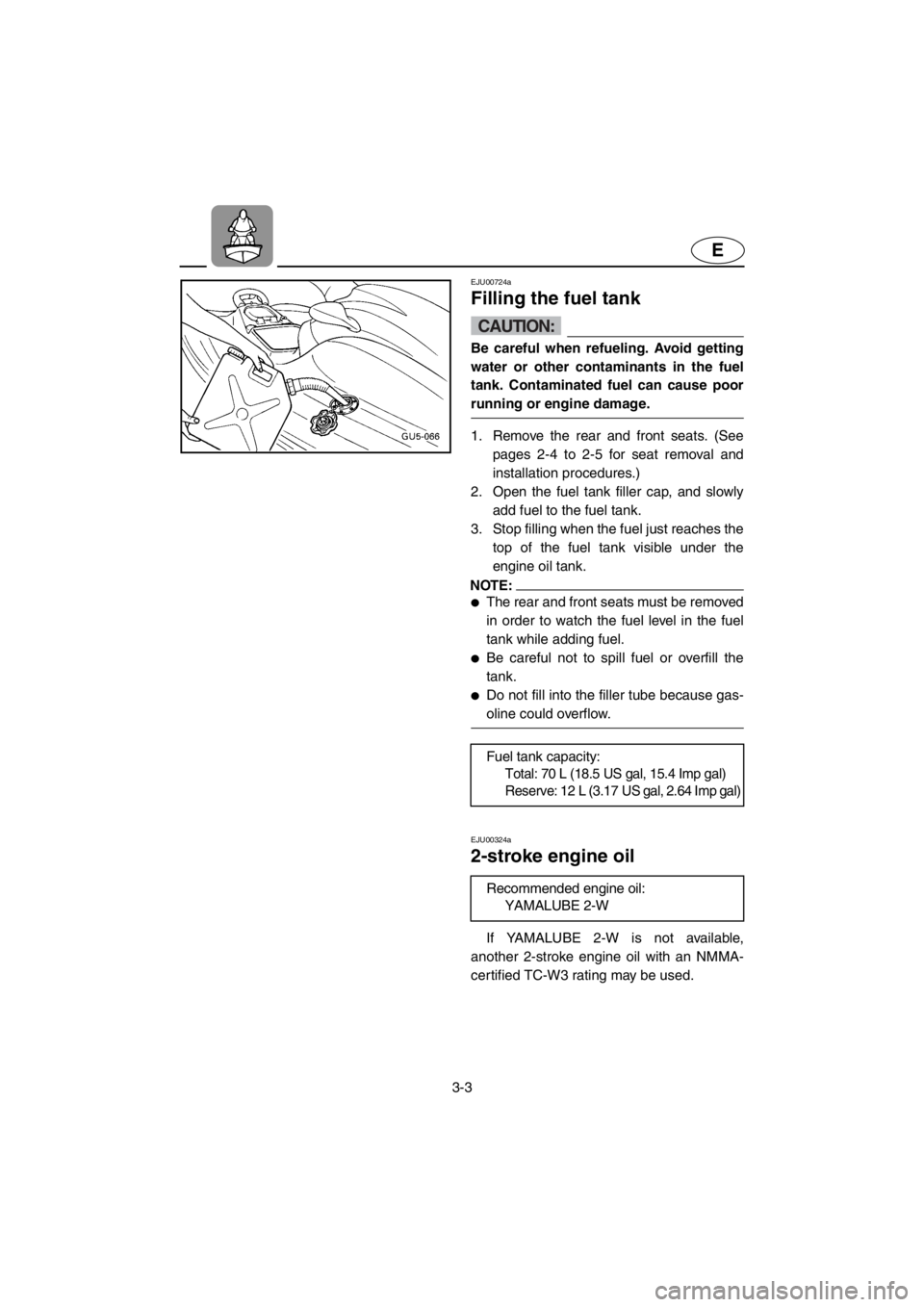
3-3
E
EJU00724a
Filling the fuel tank
CAUTION:
Be careful when refueling. Avoid getting
water or other contaminants in the fuel
tank. Contaminated fuel can cause poor
running or engine damage.
1. Remove the rear and front seats. (See
pages 2-4 to 2-5 for seat removal and
installation procedures.)
2. Open the fuel tank filler cap, and slowly
add fuel to the fuel tank.
3. Stop filling when the fuel just reaches the
top of the fuel tank visible under the
engine oil tank.
NOTE:
●The rear and front seats must be removed
in order to watch the fuel level in the fuel
tank while adding fuel.
●Be careful not to spill fuel or overfill the
tank.
●Do not fill into the filler tube because gas-
oline could overflow.
EJU00324a
2-stroke engine oil
If YAMALUBE 2-W is not available,
another 2-stroke engine oil with an NMMA-
certified TC-W3 rating may be used.Fuel tank capacity:
Total: 70 L (18.5 US gal, 15.4 Imp gal)
Reserve: 12 L (3.17 US gal, 2.64 Imp gal)
Recommended engine oil:
YAMALUBE 2-W
E_GU5-71-3.fm Page 3 Thursday, July 13, 2000 7:52 PM
Page 63 of 135
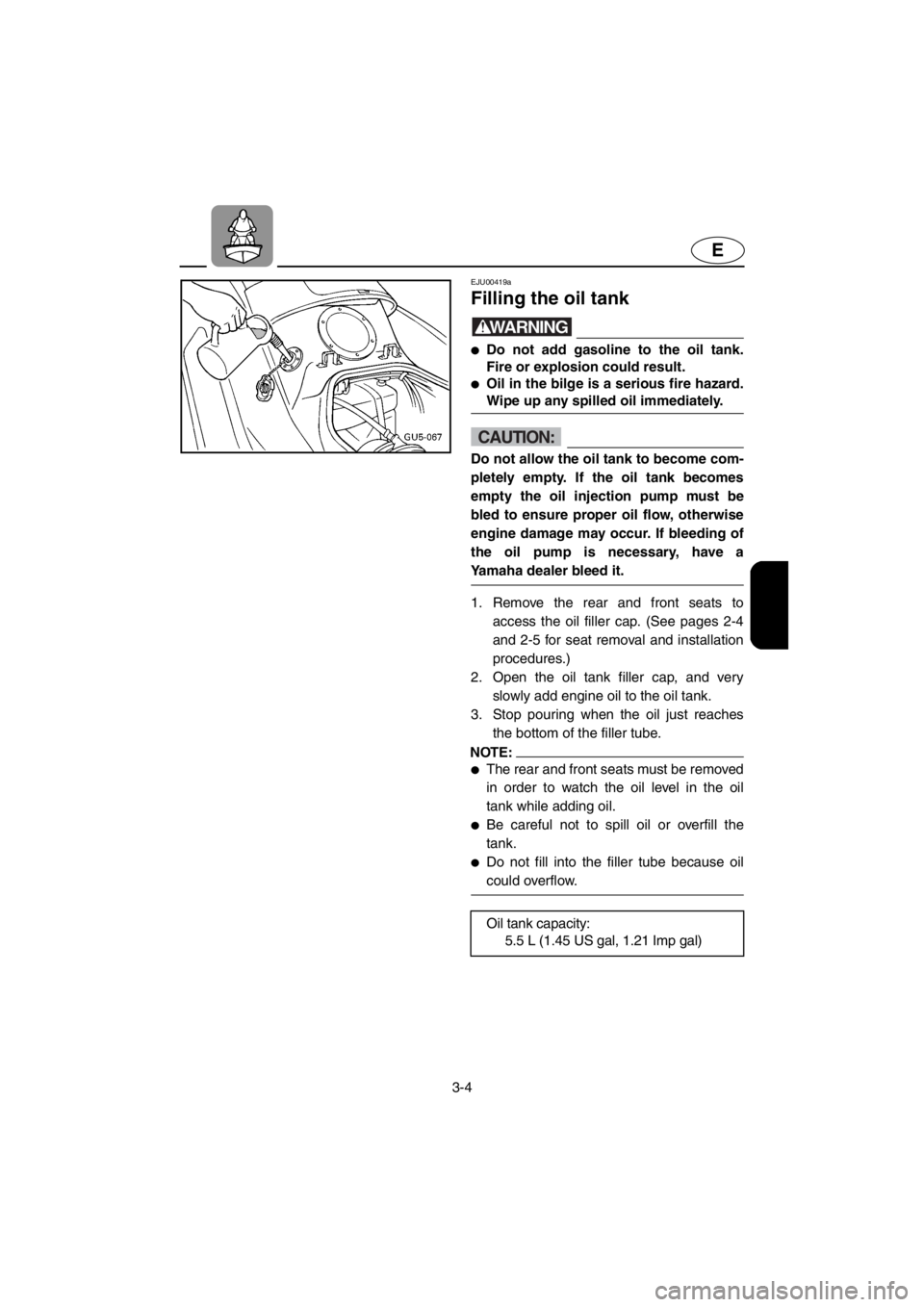
3-4
E
EJU00419a
Filling the oil tank
WARNING
●Do not add gasoline to the oil tank.
Fire or explosion could result.
●Oil in the bilge is a serious fire hazard.
Wipe up any spilled oil immediately.
CAUTION:
Do not allow the oil tank to become com-
pletely empty. If the oil tank becomes
empty the oil injection pump must be
bled to ensure proper oil flow, otherwise
engine damage may occur. If bleeding of
the oil pump is necessary, have a
Yamaha dealer bleed it.
1. Remove the rear and front seats to
access the oil filler cap. (See pages 2-4
and 2-5 for seat removal and installation
procedures.)
2. Open the oil tank filler cap, and very
slowly add engine oil to the oil tank.
3. Stop pouring when the oil just reaches
the bottom of the filler tube.
NOTE:
●The rear and front seats must be removed
in order to watch the oil level in the oil
tank while adding oil.
●Be careful not to spill oil or overfill the
tank.
●Do not fill into the filler tube because oil
could overflow.
Oil tank capacity:
5.5 L (1.45 US gal, 1.21 Imp gal)
E_GU5-71-3.fm Page 4 Thursday, July 13, 2000 7:52 PM
Page 64 of 135
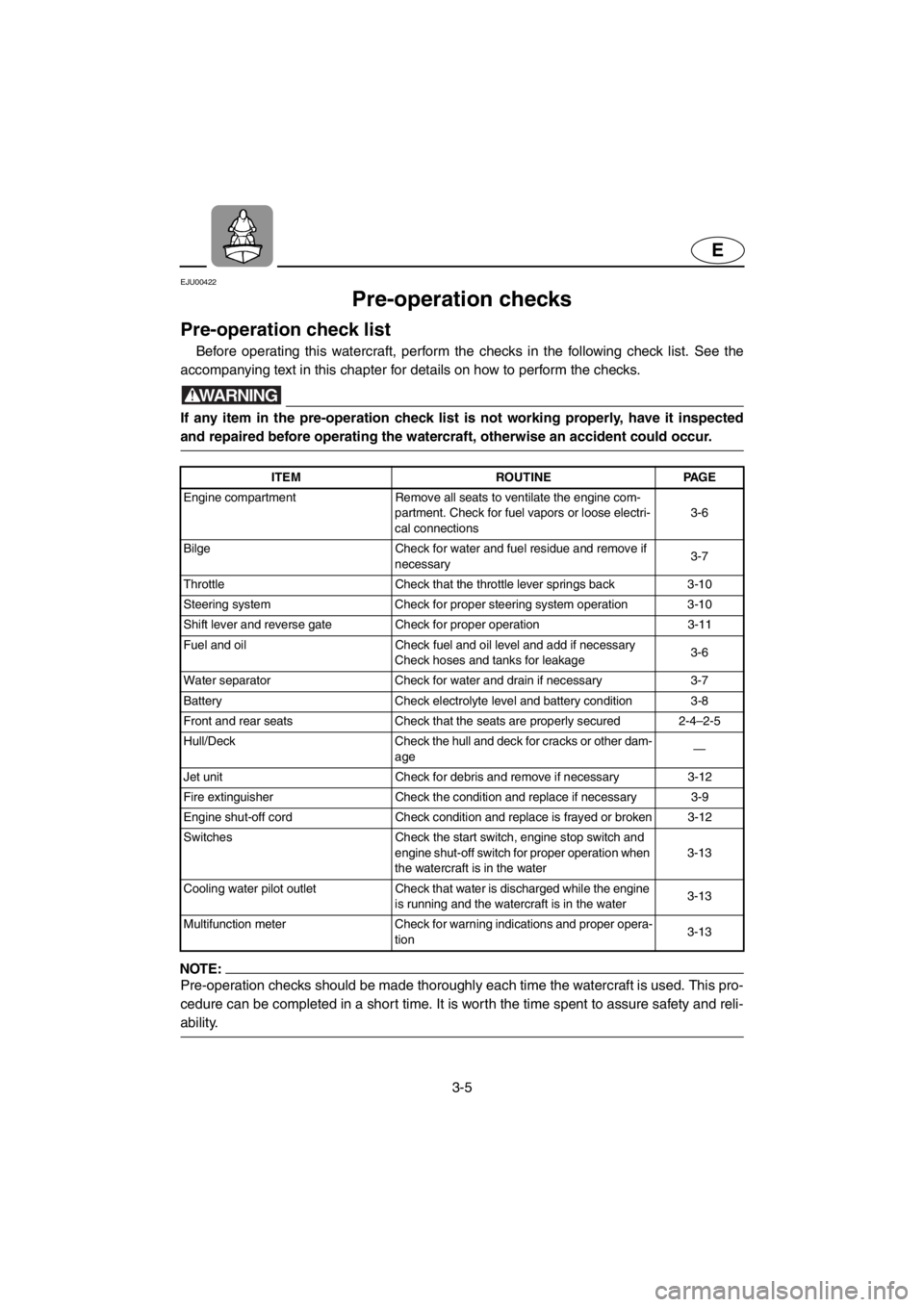
3-5
E
EJU00422
Pre-operation checks
Pre-operation check list
Before operating this watercraft, perform the checks in the following check list. See the
accompanying text in this chapter for details on how to perform the checks.
WARNING
If any item in the pre-operation check list is not working properly, have it inspected
and repaired before operating the watercraft, otherwise an accident could occur.
NOTE:
Pre-operation checks should be made thoroughly each time the watercraft is used. This pro-
cedure can be completed in a short time. It is worth the time spent to assure safety and reli-
ability.
ITEM ROUTINE PAGE
Engine compartment Remove all seats to ventilate the engine com-
partment. Check for fuel vapors or loose electri-
cal connections3-6
Bilge Check for water and fuel residue and remove if
necessary3-7
Throttle Check that the throttle lever springs back 3-10
Steering system Check for proper steering system operation 3-10
Shift lever and reverse gate Check for proper operation 3-11
Fuel and oil Check fuel and oil level and add if necessary
Check hoses and tanks for leakage3-6
Water separator Check for water and drain if necessary 3-7
Battery Check electrolyte level and battery condition 3-8
Front and rear seats Check that the seats are properly secured 2-4–2-5
Hull/Deck Check the hull and deck for cracks or other dam-
age—
Jet unit Check for debris and remove if necessary 3-12
Fire extinguisher Check the condition and replace if necessary 3-9
Engine shut-off cord Check condition and replace is frayed or broken 3-12
Switches Check the start switch, engine stop switch and
engine shut-off switch for proper operation when
the watercraft is in the water3-13
Cooling water pilot outlet Check that water is discharged while the engine
is running and the watercraft is in the water3-13
Multifunction meter Check for warning indications and proper opera-
tion3-13
E_GU5-71-3.fm Page 5 Thursday, July 13, 2000 7:52 PM
Page 65 of 135
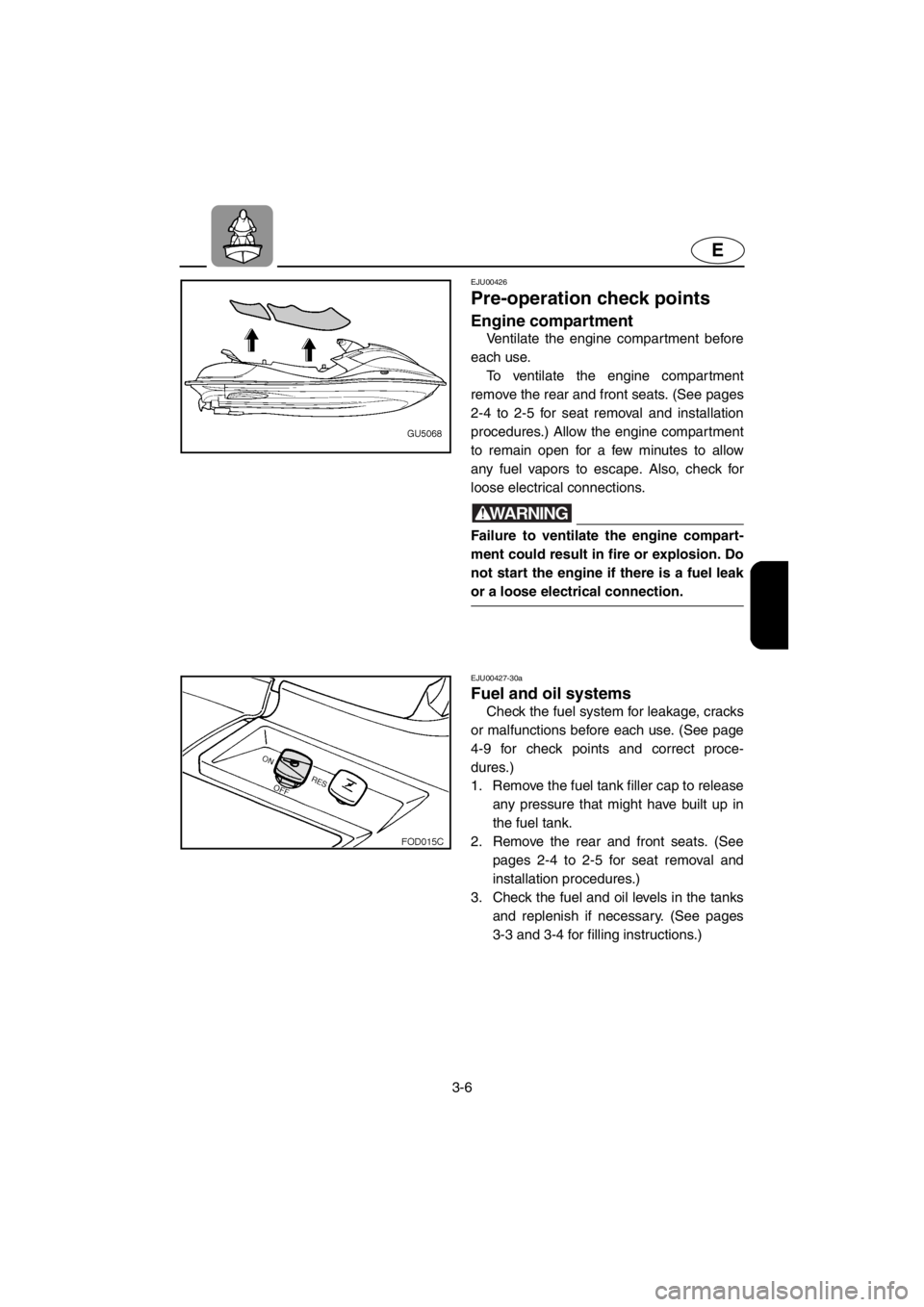
3-6
E
EJU00426
Pre-operation check points
Engine compartment
Ventilate the engine compar tment before
each use.
To ventilate the engine compartment
remove the rear and front seats. (See pages
2-4 to 2-5 for seat removal and installation
procedures.) Allow the engine compartment
to remain open for a few minutes to allow
any fuel vapors to escape. Also, check for
loose electrical connections.
WARNING
Failure to ventilate the engine compart-
ment could result in fire or explosion. Do
not start the engine if there is a fuel leak
or a loose electrical connection.
EJU00427-30a
Fuel and oil systems
Check the fuel system for leakage, cracks
or malfunctions before each use. (See page
4-9 for check points and correct proce-
dures.)
1. Remove the fuel tank filler cap to release
any pressure that might have built up in
the fuel tank.
2. Remove the rear and front seats. (See
pages 2-4 to 2-5 for seat removal and
installation procedures.)
3. Check the fuel and oil levels in the tanks
and replenish if necessary. (See pages
3-3 and 3-4 for filling instructions.)
E_GU5-71-3.fm Page 6 Thursday, July 13, 2000 7:52 PM
Page 66 of 135
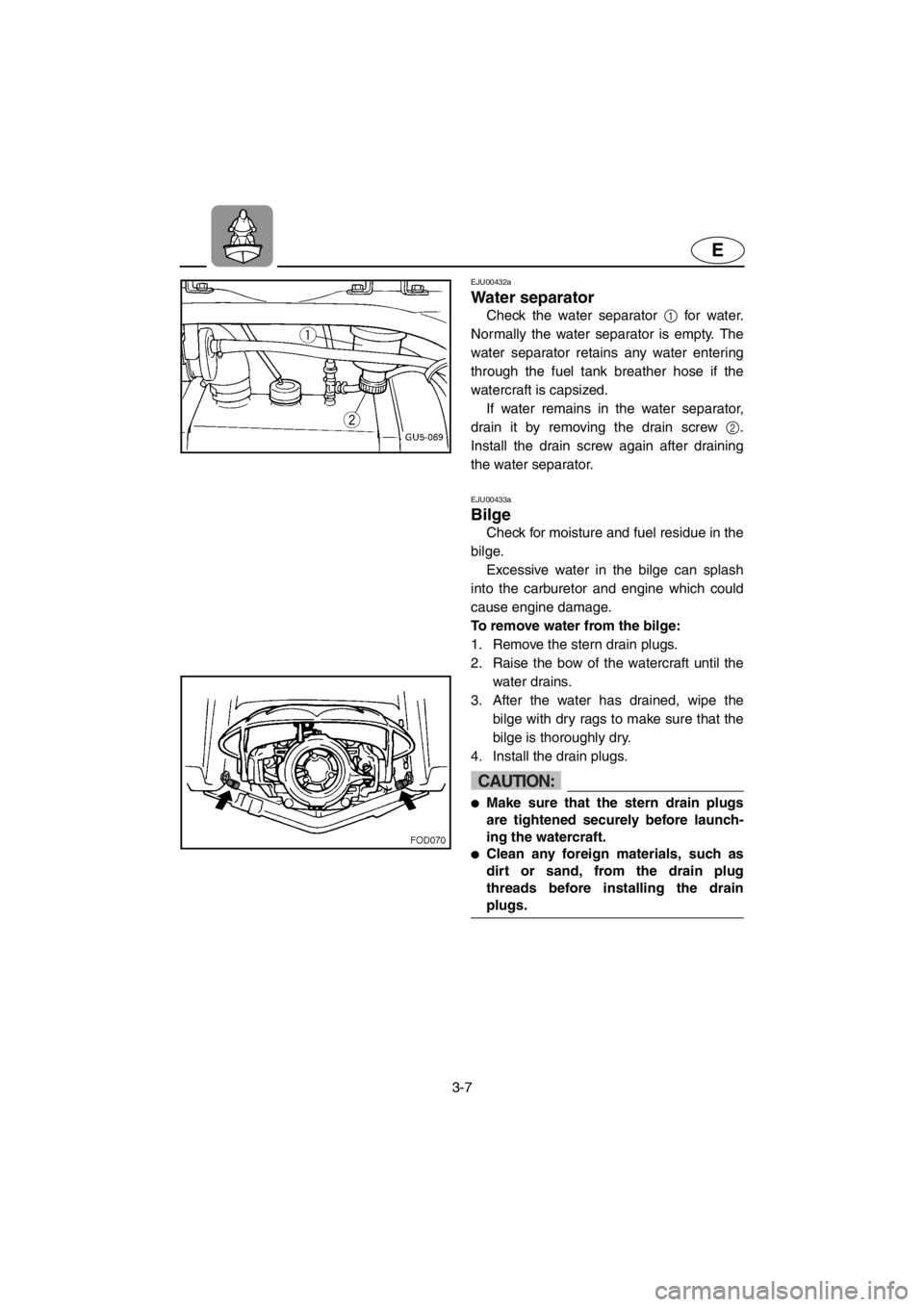
3-7
E
EJU00432a
Water separator
Check the water separator 1 for water.
Normally the water separator is empty. The
water separator retains any water entering
through the fuel tank breather hose if the
watercraft is capsized.
If water remains in the water separator,
drain it by removing the drain screw 2.
Install the drain screw again after draining
the water separator.
EJU00433a
Bilge
Check for moisture and fuel residue in the
bilge.
Excessive water in the bilge can splash
into the carburetor and engine which could
cause engine damage.
To remove water from the bilge:
1. Remove the stern drain plugs.
2. Raise the bow of the watercraft until the
water drains.
3. After the water has drained, wipe the
bilge with dry rags to make sure that the
bilge is thoroughly dry.
4. Install the drain plugs.
CAUTION:
●Make sure that the stern drain plugs
are tightened securely before launch-
ing the watercraft.
●Clean any foreign materials, such as
dirt or sand, from the drain plug
threads before installing the drain
plugs.
E_GU5-71-3.fm Page 7 Thursday, July 13, 2000 7:52 PM
Page 67 of 135
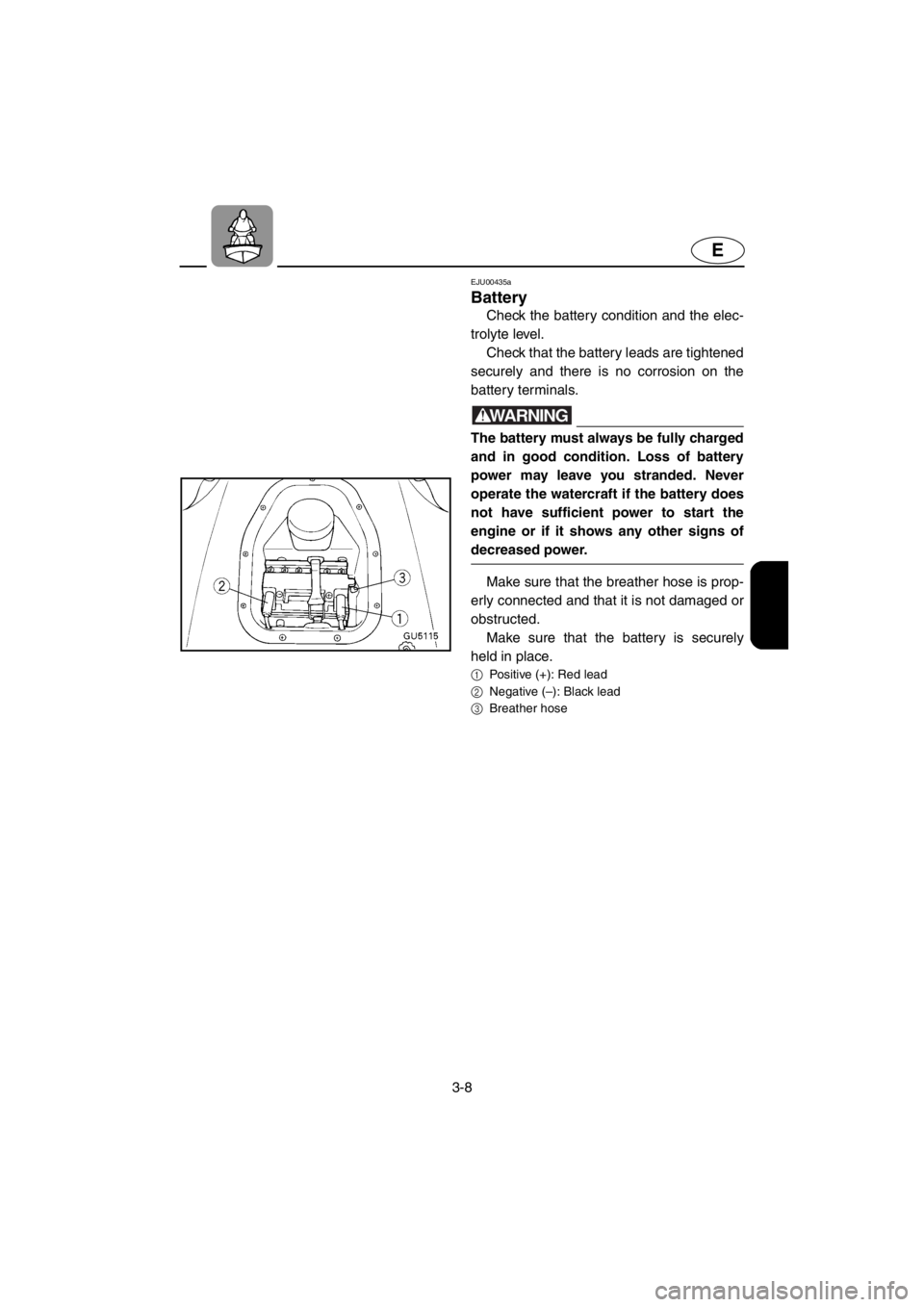
3-8
E
EJU00435a
Battery
Check the battery condition and the elec-
trolyte level.
Check that the battery leads are tightened
securely and there is no corrosion on the
battery terminals.
WARNING
The battery must always be fully charged
and in good condition. Loss of battery
power may leave you stranded. Never
operate the watercraft if the battery does
not have sufficient power to start the
engine or if it shows any other signs of
decreased power.
Make sure that the breather hose is prop-
erly connected and that it is not damaged or
obstructed.
Make sure that the battery is securely
held in place.
1
Positive (+): Red lead
2
Negative (–): Black lead
3
Breather hose
E_GU5-71-3.fm Page 8 Thursday, July 13, 2000 7:52 PM
Page 68 of 135
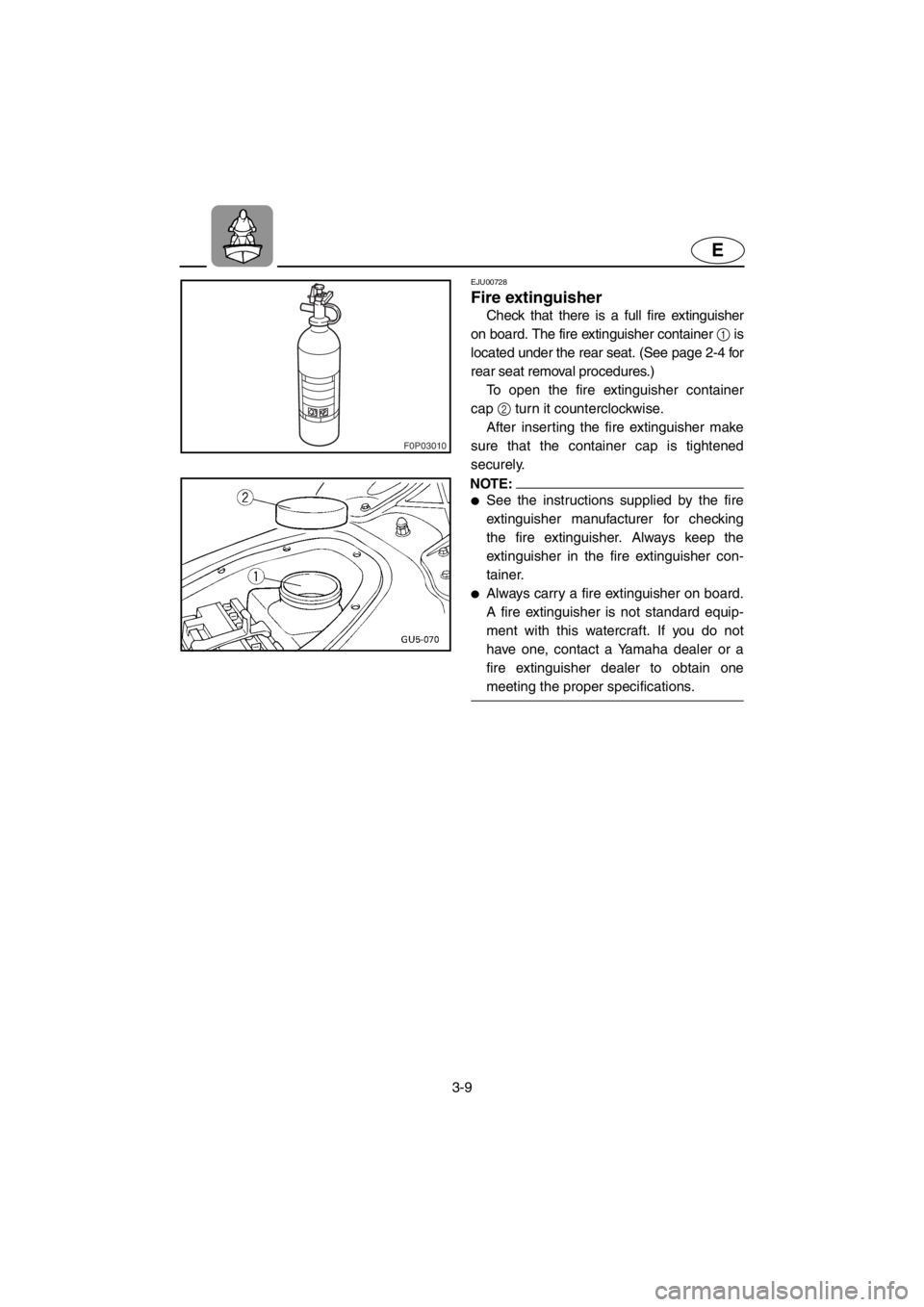
3-9
E
F0P03010
EJU00728
Fire extinguisher
Check that there is a full fire extinguisher
on board. The fire extinguisher container 1 is
located under the rear seat. (See page 2-4 for
rear seat removal procedures.)
To open the fire extinguisher container
cap2 turn it counterclockwise.
After inserting the fire extinguisher make
sure that the container cap is tightened
securely.
NOTE:
●See the instructions supplied by the fire
extinguisher manufacturer for checking
the fire extinguisher. Always keep the
extinguisher in the fire extinguisher con-
tainer.
●Always carry a fire extinguisher on board.
A fire extinguisher is not standard equip-
ment with this watercraft. If you do not
have one, contact a Yamaha dealer or a
fire extinguisher dealer to obtain one
meeting the proper specifications.
E_GU5-71-3.fm Page 9 Thursday, July 13, 2000 7:52 PM
Page 69 of 135
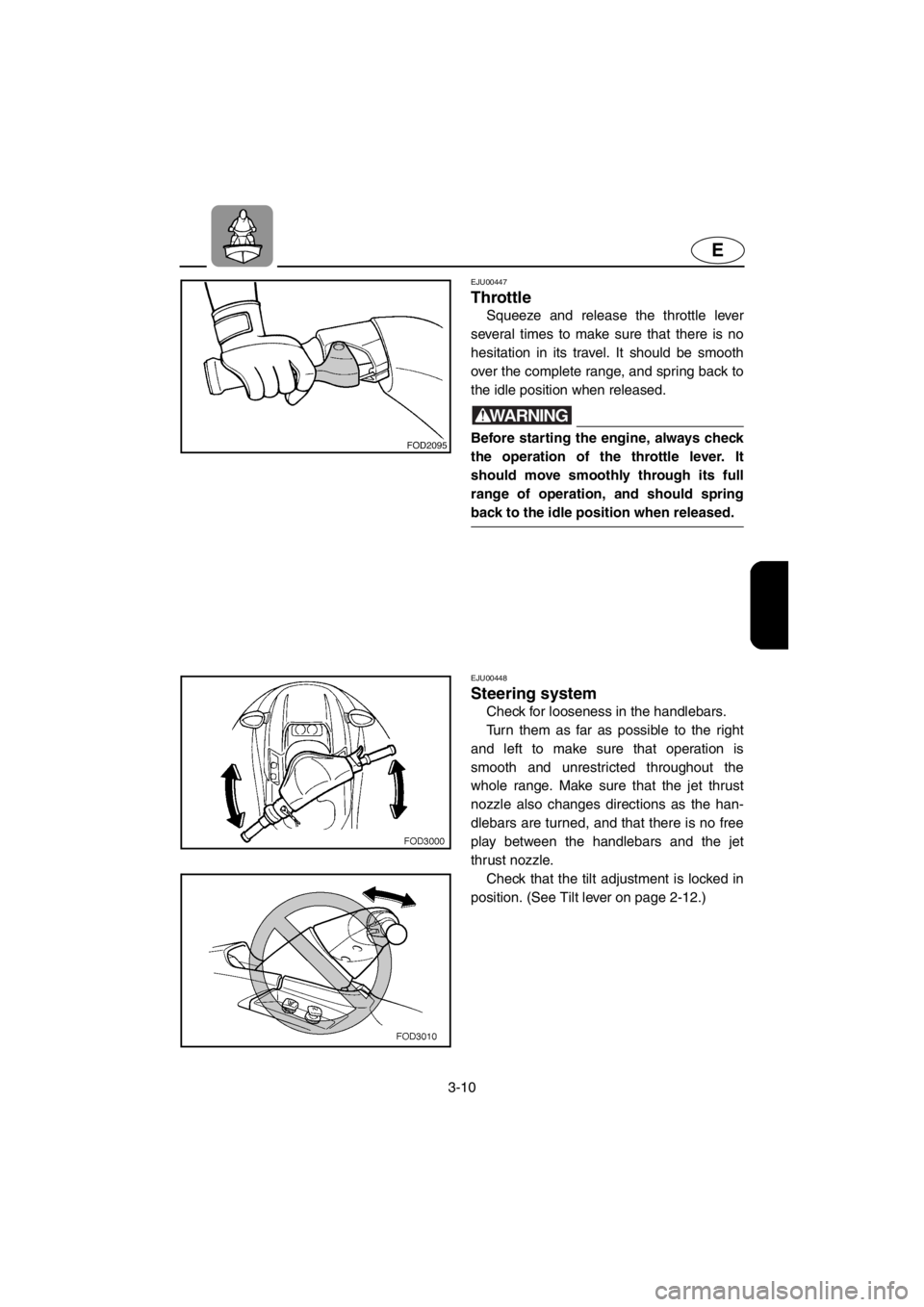
3-10
E
EJU00447
Throttle
Squeeze and release the throttle lever
several times to make sure that there is no
hesitation in its travel. It should be smooth
over the complete range, and spring back to
the idle position when released.
WARNING
Before starting the engine, always check
the operation of the throttle lever. It
should move smoothly through its full
range of operation, and should spring
back to the idle position when released.
EJU00448
Steering system
Check for looseness in the handlebars.
Turn them as far as possible to the right
and left to make sure that operation is
smooth and unrestricted throughout the
whole range. Make sure that the jet thrust
nozzle also changes directions as the han-
dlebars are turned, and that there is no free
play between the handlebars and the jet
thrust nozzle.
Check that the tilt adjustment is locked in
position. (See Tilt lever on page 2-12.)
E_GU5-71-3.fm Page 10 Thursday, July 13, 2000 7:52 PM
Page 70 of 135
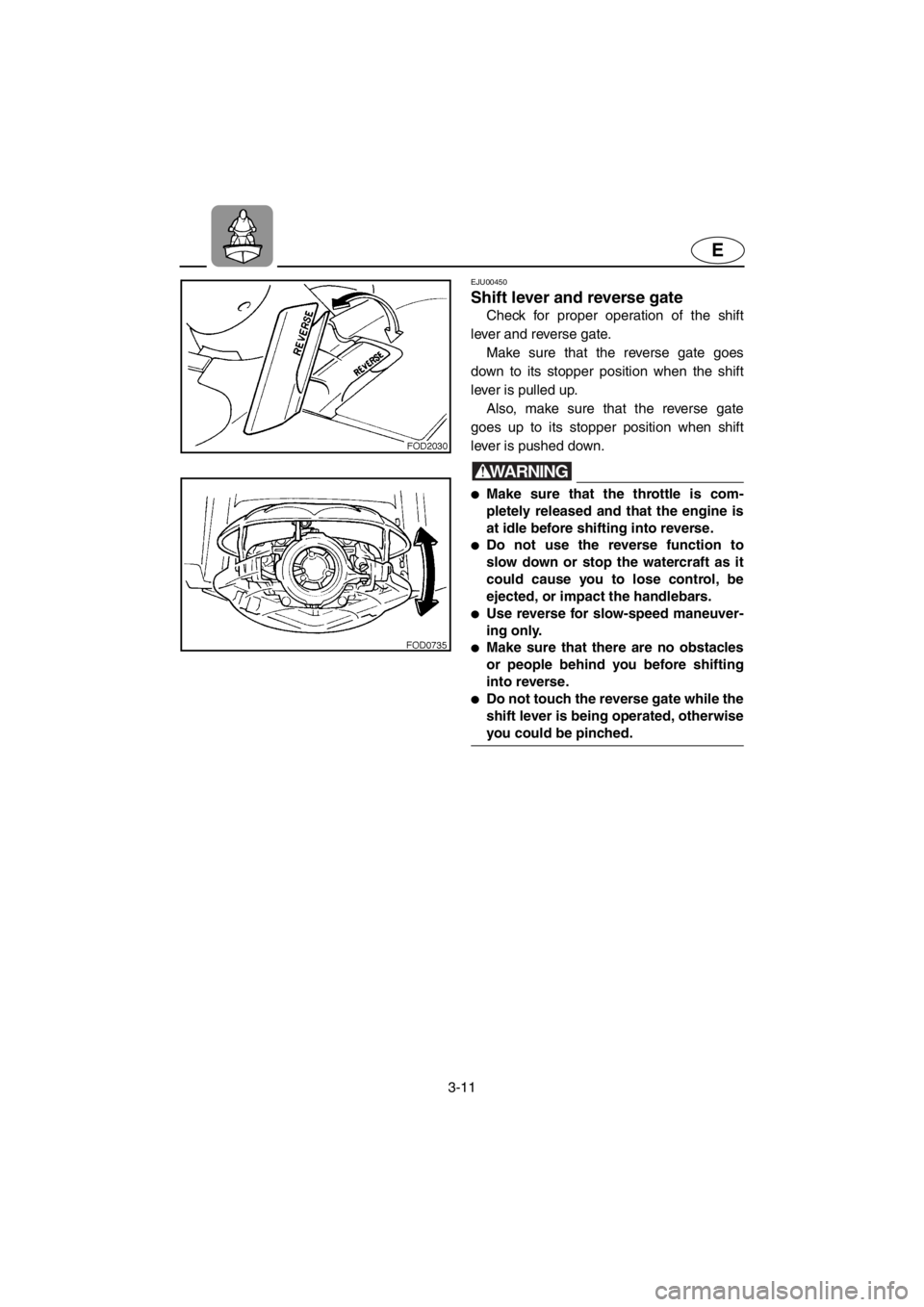
3-11
E
EJU00450
Shift lever and reverse gate
Check for proper operation of the shift
lever and reverse gate.
Make sure that the reverse gate goes
down to its stopper position when the shift
lever is pulled up.
Also, make sure that the reverse gate
goes up to its stopper position when shift
lever is pushed down.
WARNINGJJ●Make sure that the throttle is com-
pletely released and that the engine is
at idle before shifting into reverse.
●Do not use the reverse function to
slow down or stop the watercraft as it
could cause you to lose control, be
ejected, or impact the handlebars.
●Use reverse for slow-speed maneuver-
ing only.
●Make sure that there are no obstacles
or people behind you before shifting
into reverse.
●Do not touch the reverse gate while the
shift lever is being operated, otherwise
you could be pinched.
E_GU5-71-3.fm Page 11 Thursday, July 13, 2000 7:52 PM